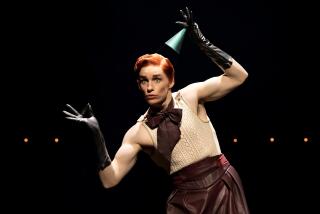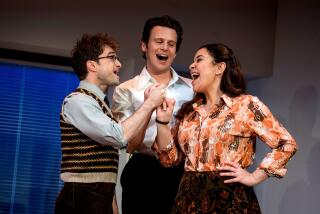‘Jesus Christ Superstar’ a love triangle?
— Take away the miracles, the bluesy guitar licks and all those antsy apostles, and what’s “Jesus Christ Superstar” really about?
Des McAnuff thinks he has the answer.
It’s a love triangle among Jesus, Judas and Mary Magdalene, said the U.S.-Canadian director of the critically heralded, Broadway-bound production of the Andrew Lloyd Webber and Tim Rice musical that’s running through year’s end at the La Jolla Playhouse.
Actually, McAnuff said, he heard lyricist Rice deliver that revisionist take on the New Testament during a TV interview. The comment stuck with him as he began planning the revival of the ‘70s entertainment phenomenon that originated and ran last summer at Canada’s Stratford Shakespeare Festival, where McAnuff presides as artistic director.
Building an interpretation of Jesus’ final days around the idea that Judas and Mary Magdalene were vying for the Christian Messiah’s affections is “obviously a very secular take on Christ,” said McAnuff, 59, who as a suburban Toronto youth attended Bible school and was a server in the Anglican Church.
“But I think for a lot of people it’s really a secular look at these three people,” continued McAnuff, whose Broadway musical credits include “The Who’s Tommy” and “Jersey Boys.” “And most of us have some kind of experience with relationships like this, whether it’s two men in love with the same girl or whatever it happens to be.”
Making a 2,000-year-old story feel accessible and contemporary was, of course, a key to the success of “Jesus Christ Superstar,” one of the very few Broadway scores that managed to translate 1960s political angst, hippie-era optimism and the musical vernacular of rock ‘n’ roll in a way that spoke to audience members south of 30 years old.
When the show opened on Broadway in October 1971, many U.S. critics sat on their hands, and some religious leaders cried “blasphemy!”
But by then the original, pre-Broadway concept album already had become a breakout international smash for the Lloyd Webber-Rice duo, launching future musical-theater collaborations like “Evita” and opening a path for separate projects including “The Phantom of the Opera” (Lloyd Webber) and “The Lion King” (Rice, with Elton John). Meanwhile, “Jesus Christ Superstar” went on to a long touring afterlife, in staged and concert versions, around the globe.
This year, with youthful protesters taking to the streets and challenging the political status quo from Tahrir Square to Zuccotti Park, McAnuff believes that “Jesus Christ Superstar’s” time has come around again. “It feels like you’re watching Jerusalem through CNN,” he said.
As it happens, the production’s classically trained star, Paul Nolan, won’t be the only singing savior on Broadway this season: a new production of another ‘70s musical passion play, Stephen Schwartz’s “Godspell,” opened there this fall.
“It’s interesting,” McAnuff said of the messianic convergence. “I can’t imagine two more different, almost polar-opposite shows, than ‘Jesus Christ Superstar’ and ‘Godspell.’ They happen to cover the same subject matter, but from completely different points of view…. Throw in ‘Book of Mormon’ — and by the way I’m also doing ‘Faust’ at the Met [Metropolitan Opera] — so I’m doing my Jesus Christ/God show and then I’m doing my devil show at the same time.”
Seeking to recapture the music’s raw verve, McAnuff went back for inspiration to the original concept album, which featured such vocal talents as Murray Head and Deep Purple frontman Ian Gillan, plus a troupe of crack musicians bending their fierce guitar solos and explosive drum rolls just enough to fit Lloyd Webber’s tight orchestrations. McAnuff said he and his musical team stuck as closely as possible to those original arrangements.
Apart from a notable dissent by the New York Times, McAnuff’s production has received nearly unanimous raves (“Superb” — Chicago Tribune; “Brilliant” — Ottawa Citizen). But the most cherished one may have come from its composer. “It is very probably the best acted performance of the show I have ever seen,” Lloyd Webber wrote on his website.
“He [McAnuff] does bring a really unexpected slant to it,” said Christopher Ashley, La Jolla’s artistic director. “He does have a real feel for rock music, and the rock concert is shining out of every bit of his production.”
Although several years younger than the show’s creators, McAnuff identifies himself as the artistic offspring of the same 1960s-vintage social upheaval and cultural experimentation that spawned “Superstar.”
The two-time Tony and Olivier Award recipient first gained attention while still in his 20s as the hotshot young founder-director of the Dodger Theater Company. He also was the controversial author of works like the “The Death of Von Richthofen as Witnessed From Earth,” a freewheeling play-with-music inspired by the World War I German flying ace, produced for Joseph Papp’s Public Theater.
Taking over the moribund La Jolla Playhouse as artistic director in the early 1980s, McAnuff injected fresh ideas into the company, favoring new spins on the classics, recruiting iconoclastic young directors like Peter Sellars, and getting conservative San Diego playgoers to come along for the wild ride.
“Des really re-founded that theater,” Ashley said. “It was a theater that was originally founded in the ‘40s then had gone dormant for a couple of decades. It was really a theater that he created.”
During his tenures at La Jolla and Stratford, McAnuff has continued to lure audiences by programming a mix of contemporary plays, imaginative new versions of Shakespeare, Chekhov and Brecht, and splashy but thoughtful musicals such as “The Who’s Tommy.” He also has directed movies, including a 1998 adaptation of Balzac’s “Cousin Bette,” starring Jessica Lange.
It’s a method for making theater, McAnuff said, that he learned from such mentors as Michael Langham, his esteemed Stratford predecessor.
“Musicals are a legitimate part of the repertoire. How can you not take ‘West Side Story’ seriously? It’s a masterpiece, and belongs on the same stage as Eugene O’Neill.”
More to Read
The biggest entertainment stories
Get our big stories about Hollywood, film, television, music, arts, culture and more right in your inbox as soon as they publish.
You may occasionally receive promotional content from the Los Angeles Times.






